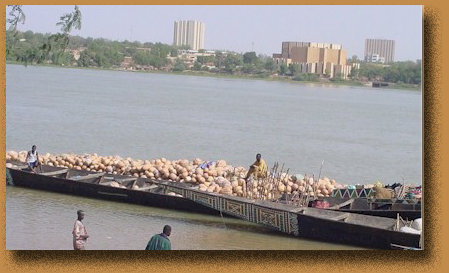
Economy Overview: Niger is a poor, landlocked Sub-Saharan nation, whose economy centers on subsistence agriculture, animal husbandry, and reexport trade, and increasingly less on uranium, because of declining world demand. The 50% devaluation of the West African franc in January 1994 boosted exports of livestock,cowpeas, onions, and the products of Niger's small cotton industry. The government relies on bilateral and multilateral aid - which was suspended following the April 1999 coup d'etat - for operating expenses and public investment. In 2000-01, the World Bank approved a structural adjustment loan of $105 million to help support fiscal reforms. However, reforms could prove difficult given the government's bleak financial situation. The IMF approved a $73 million poverty reduction and growth facility for Niger in 2000 and announced $115 million in debt relief under the Heavily Indebted Poor Countries (HIPC) initiative. Further disbursements of aid occurred in 2002. Future growth may be sustained by exploitation of oil, gold, coal, and other mineral resources.
GDP - per capita: purchasing power parity- $800 (2004 est.)
GDP -composition by sector: agriculture:39%, industry: 17%, services: 44% (2001)
Population below poverty line: 63%(1993 est.)
Inflation rate (consumer prices):3% (2002 est.)
Labor force: 70,000 receive regular wages or salaries (2002 est.)
Labor force - by occupation:agriculture 90%, industry and commerce 6%, government 4%
Budget: revenues: $320 million -including $134 million from foreign sources
Expenditures: $320 million, including capital expenditures of $178 million (2002 est.)
Agriculture products: cowpeas,cotton, peanuts, millet, sorghum, cassava (tapioca), rice; cattle,sheep, goats, camels, donkeys, horses, poultry
Industries:uranium mining, cement,brick, textiles, food processing, chemicals, slaughter houses
Electricity production:242 million kWh (2001)
Electricity consumption: 325.1 million kWh (2001)
Oil production: 0 bbl/day (2001 est.)
Oil consumption: 5,000 bbl/day (2001 est.)
Exports: $280 million f.o.b.(2002 est.)
Exports commodities: uranium ore, livestock, cowpeas, onions
Exports partners:France 42.2%, Nigeria 28.9%, Japan17.2%, Spain 4.4%(2003)
Imports: $400 million f.o.b.(2002 est.)
Imports commodities: foodstuffs,machinery, vehicles and parts, petroleum, cereals
Imports partners: France16.4%, Cote d'Ivoire 13.8%, China 10.5%, Nigeria 7.7%, US 5.5%, Japan4.9% (2003)
Debt external: $1.6 billion (1999 est.)
Economic aid recipient: $341 million (1997)
Currency: Communaute Financiere Africaine franc (XOF); note - responsible authority is the Central Bankof the West African States
Currency code:XOF Click here to find current rate
Source:CIA World Factbook